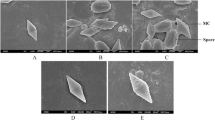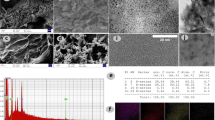Abstract
A new tool to provide an environmentally friendly way to deliver active proteins to the environment has been developed, based on the use of polyhydroxyalkanoate (PHA, bioplastic) granules. To illustrate this novel approach, a derived Cry1Ab insect-specific toxin protein was in vivo immobilized into PHA granules through the polypeptide tag BioF. The new toxin, named Fk-Bt1, was shown to be active against Sesamia nonagrioides (Lepidoptera: Noctuidae). The dose–mortality responses of the new toxin granule formulation (PFk-Bt1) and purified Cry1Ab have been compared, demonstrating the effectiveness of PFk-Bt1 and suggesting a common mode of action.


Similar content being viewed by others
References
Almond BD, Dean H (1994) Intracellular proteolysis and limited diversity of the Bacillus thuringiensis CryIA family of the insecticidal crystal proteins. Biochem Biophys Res Commun 201:788–794
de Lorenzo V (2001) Cleaning up behind us. The potential of genetically modified bacteria to break down toxic pollutants in the environment. EMBO Rep 2:357–359
de Lorenzo V, Eltis L, Kessler B, Timmis K (1993) Analysis of Pseudomonas gene products using lacIq/Ptrp-lac plasmids and transposons that confer conditional phenotypes. Gene 123:17–24
Durner R, Zinn M, Witholt B, Egli T (2001) Accumulation of poly[(R)-3-hydroxyalkanoates] in Pseudomonas oleovorans during growth in batch and chemostat culture with different carbon sources. Biotechnol Bioeng 72:278–288
Glare TR, O’Callaghan M (2000) Bacillus thuringiensis: biology, ecology and safety. Wiley, Chichester, p 368
González-Núñez M, Ortego F, Castañera P (2000) Susceptibility of Spanish populations of the corn borers Sesamia nonagrioides (Lepidoptera: Noctuidae) and Ostrinia nubilalis (Lepidoptera: Crambidae) to a Bacillusthuringiensis endotoxin. J Econ Entomol 93:459–463
Herrero M, de Lorenzo V, Timmis KN (1990) Transposon vector containing non-antibiotic selection markers for cloning and stable chromosomal insertion of foreign DNA in gram-negative bacteria. J Bacteriol 172:6557–6567
Huisman GW, Wonink E, de Koning GJM, Preusting H, Witholt B (1992) Synthesis of poly(3-hydroxyalkanoates) by mutant and recombinant Pseudomonas strains. Appl Microbiol Biotechnol 38:1–5
Johnson DE, Niezgodski DM, Twaddle GM (1980) Parasporal crystals produced by oligosporogenous mutans of Bacillus thuringiensis (Spo−Cr+). Can J Microbiol 26:486–491
Kraak MN, Smits THM, Kessler B, Witholt B (1997) Polymerase C1 levels and poly(R-3-hydroxyalkanoate) synthesis in wild-type and recombinant Pseudomonas strains. J Bacteriol 179:4985–4991
Lageveen RG, Huisman GW, Preusting H, Ketelaar P, Eggink G, Witholt B (1988) Formation of polyesters by Pseudomonas oleovorans: effect of substrates on formation and composition of poly-(R)-3-hydroxyalkanoates and poly-(R)-3-hydroxyalkenoates. Appl Environ Microbiol 54:2924–2932
La Vallie ER, McCoy JM (1995) Gene fusion expression systems in Escherichia coli. Curr Opin Biotechnol 6:501–506
LeOra Software (1987) POLO-PC, user’s guide to probit or logit analysis. LeOra Software, Berkeley, CA
Liebergesell M, Schmidt B, Steinbüchel A (1992) Isolation and identification of granule-associated proteins relevant for poly(3-hydroxyalkanoic acid) biosynthesis in Chromatium vinosum D. FEMS Microbiol Lett 99:227–232
Madison LL, Huisman GW (1999) Metabolic engineering of poly(3-hydroxyalkanoates): from DNA to plastic. Microbiol Mol Biol Rev 63:21–53
McCool GJ, Cannon MC (1999) Polyhydroxyalkanoate inclusion body-associated proteins and coding region in Bacillus megaterium. J Bacteriol 181:585–592
Mezei LM, Storts DR (1994) In: Griffin HG, Griffin AM (eds) PCR technology: current innovations. CRC Press, Boca Raton, FL, USA
Moldes C, García P, García JL, Prieto MA (2004) In vivo immobilization of fusion proteins on bioplastics by the novel tag BioF. Appl Environ Microbiol 70:3205–3212
Morales-Ramos LH, McGuire MR, Galán-Wong LJ (1998) Utilization of several biopolymers for granular formulations of Bacillus thuringiensis. J Econ Entomol 91:1109–1113
Navon A (2000) Bacillus thuringiensis insecticides in crop protection—reality and prospects. Crop Prot 19:669–676
Pieper-Fürst U, Madkour MH, Mayer F, Steinbüchel A (1995) Identification of the region of a 14-kilodalton protein of Rhodococcus ruber that is responsible for the binding of this phasin to the polyhydroxyalkanoic acid granules. J Bacteriol 177:2513–2523
Pötter M, Steinbüchel A (2005) Poly(3-hydroxybutyrate) granule-associated proteins: impacts on poly(3-hydroxybutyrate) synthesis and degradation. Biomacromolecules 6:552–560
Prieto MA, Buehler B, Jung K, Witholt B, Kessler B (1999) PhaF, a polyhydroxyalkanoate granule associated protein of Pseudomonas oleovorans GPo1 involved in the regulatory expression system for pha genes. J Bacteriol 181:858–868
Sambrook, J Russell DW (2001) Molecular cloning. A laboratory manual. CSHL Press, Cold Spring Harbor, Nueva York
Sassenfeld HM (1990) Engineering proteins for purification. Trends Biotechnol 8:88–93
Schembri MA, Woods AA, Bayly RC, Davies JK (1995) Identification of a 13-kDa protein associated with the polyhydroxyalkanoic acid granules from Acinetobacter spp. FEMS Microbiol Lett 133:277–283
Schnepf E, Crickmore N, van Rie J, Lereclus D, Baum J, Feitelson J, Zeigler DR, Dean DH (1998) Bacillus thuringiensis and its pesticidal crystal proteins. Microbiol Mol Biol Rev 62:775–806
Sharma HC, Sharma KK, Crouch JH (2004) Genetic transformation of crops for insect resistance: potential and limitations. Crit Rev Plant Sci 23:47–72
Steinbüchel A, Hein S (2001) Biochemical and molecular basis of microbial synthesis of polyhydroxyalkanoates in microorganisms. Adv Biochem Eng Biotechnol 71:81–123
Steinbüchel A, Aerts K, Babel W, Föllner C, Liebergesell M, Madkour MH, Mayer F, Pieper-Fürst U, Pries A, Valentin HE, Wieczorek R (1995) Considerations of the structure and biochemistry of bacterial polyhydroxyalkanoic acid inclusions. Can J Microbiol 41:94–105
Uhlén M, Forsberg G, Moks T, Hartmanis M, Nilsson B (1992) Fusion proteins in biotechnology. Curr Opin Biotechnol 3:363–369
Wieczorek R, Steinbüchel A, Schmidt B (1996) Occurrence of polyhydroxyalkanoic acid granule-associated proteins related to the Alcaligenes eutrophus H16 GA24 protein in other bacteria. FEMS Microbiol Lett 135:23–30
Acknowledgements
We thank E. García, E. Díaz, and R. López for helpful comments. We also acknowledge A. Cebolla (BioMedal) for his continuous encouragement. We are grateful to Esteban Alcalde (Syngenta Seeds S.A.) for providing the Cry1Ab toxin and to Juan Ferre (Universitat de Valencia) for the Cry1Ab antibody. C. Moldes was a recipient of a fellowship of the Fundación Ramón Areces. This work was supported by grants from Fundación Ramón Areces, EU (QLK3-CT-2002-01969), and CICYT (BIO2003-05309-C04-02).
Author information
Authors and Affiliations
Corresponding author
Rights and permissions
About this article
Cite this article
Moldes, C., Farinós, G.P., de Eugenio, L.I. et al. New tool for spreading proteins to the environment: Cry1Ab toxin immobilized to bioplastics. Appl Microbiol Biotechnol 72, 88–93 (2006). https://doi.org/10.1007/s00253-005-0257-6
Received:
Revised:
Accepted:
Published:
Issue Date:
DOI: https://doi.org/10.1007/s00253-005-0257-6




